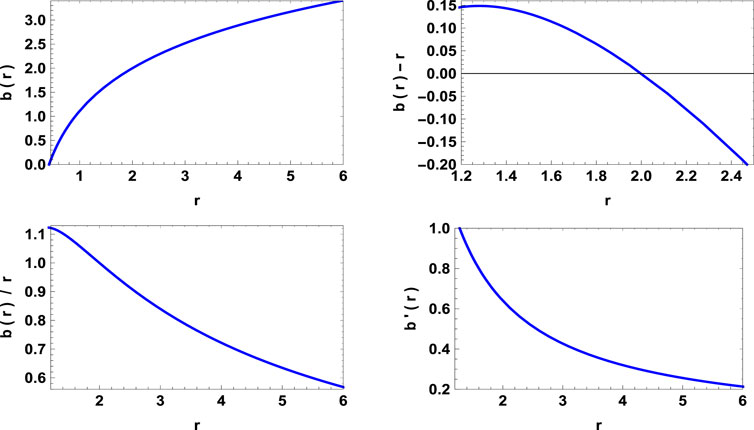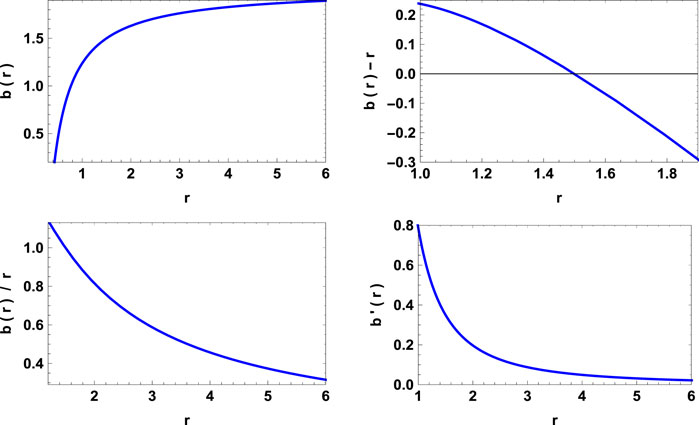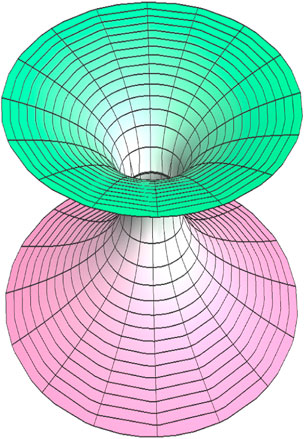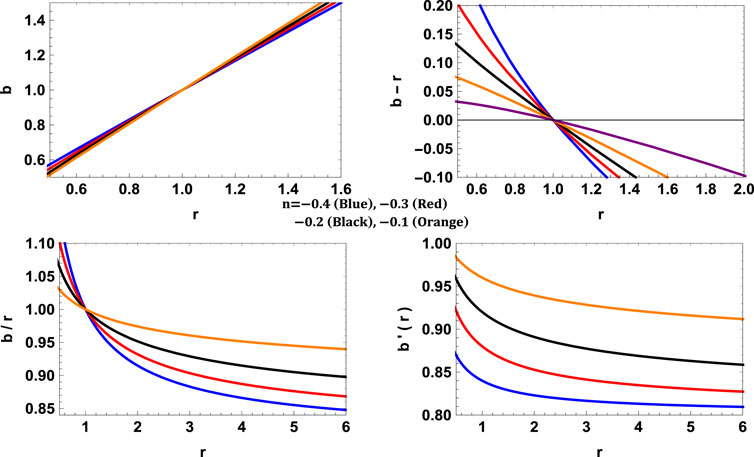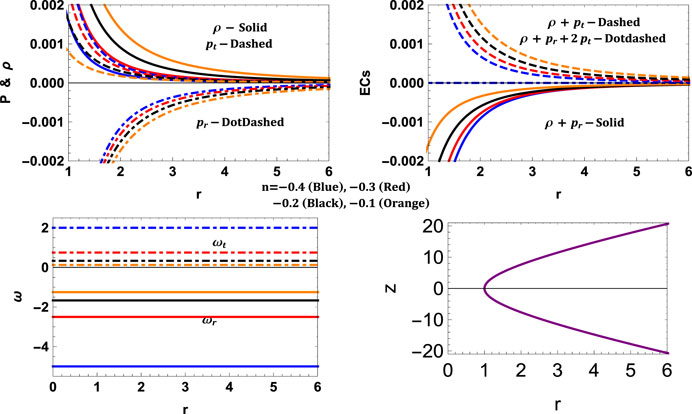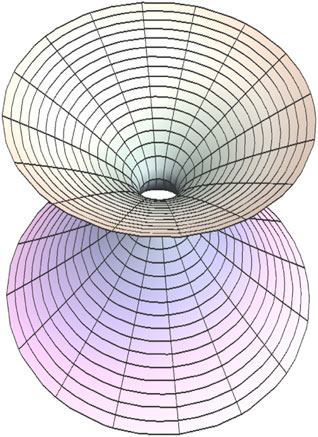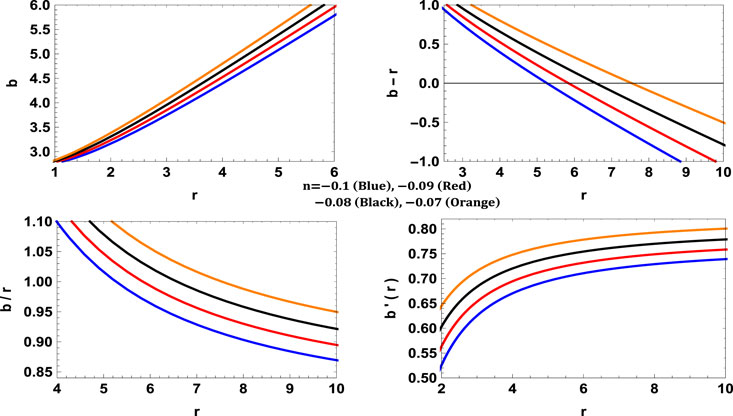- 1Department of Physics, National Defence Academy, Pune, India
- 2Department of Mathematics, Jadavpur University, Kolkata, India
- 3Department of Physics, The Institute of Mathematical Sciences, Chennai, Tamil Nadu, India
- 4Department of Mathematical and Physical Sciences, College of Arts and Sciences, University of Nizwa, Nizwa, Sultanate of Oman
This paper supplements the article (Eur. Phys. J. C 76: 246, 2016) by extending some more new wormhole solutions in the background of Finslerian geometry. Here, we present six more solutions by considering i) a linear equation of state (EoS) pr = ωρ and three different shape functions, ii) a linear relationship between radial and tangential pressure as pt = npr with two different redshift functions and iii) a specific density profile with a linear equation of state pr = ωρ. It is found that all these wormholes are violating null energy condition (NEC) signifying that the throats are opened by exotic matters. Since the equation of state parameters, ω or ωr = pr/ρ for all the solutions are
1 Introduction
Two distinct spacetimes are possible to be connected through a shortcut, which arises due to the hypothetical topological behavior of spacetime, popularly known as “wormhole”. It is interesting to note that in their work Fuller and Wheeler [1], first coined the term wormhole and provided due credit to Weyl [2] for the fundamental idea of the possibility of non-simply connected spacetime. However, according to few researchers, the study of the wormhole was actually initiated by Flamm [3]. Later an important study by Einstein and Rosen revealed the wormhole geometry popularly known as the Einstein-Rosen bridge where they investigated the non-singular coordinate patches of the Reissner-Nordström and the Schwarzschild solutions. Clearly, these two fundamental ideas of wormholes are completely different from each other. The wormholes, which are offspring of the eternal black hole solution, are not suitable for transferring information, and they are actually non-traversable in their nature. On the other hand, the idea of a wormhole due to the non-simply connected nature of spacetime as endorsed by Weyl predicts the presence of electromagnetic field lines without a source, which actually possible to be used as a classical communication channel.
With the proposal of the idea of a wormhole, researchers showed great curiosity about whether it is possible to construct a sustainable wormhole, the topological tunnel of space, and whether will it be consistent with the laws of physics. In 1962 in his seminal work Wheeler [4] predicted the Reissner-Nordström and Kerr wormhole geometries in the form of quantum foam at the Planck scale. In the further study by Hawking [7] these wormholes have been featured as “Euclidean wormholes” which are not traversable. With the suitable choice of topology this wormhole geometry which is described by the Schwarzschild metric [4], contains the horizon and it is impossible to traverse through them as its throat squeezes very quickly [5]. Hence, it is obvious to consider the presence of non-zero stress and energy to support the configuration of the wormhole throat [6]. This endorses the presence of the material near the throat that must have a radial tension greater than its mass-energy density which property has not been seen so far in any material. In their detailed study, Morris et al. [8] successfully explained static and spherically symmetric traversable wormholes which support the presence of such exotic matter that violates the energy conditions. Immediately questions arise such as i) Is it admissible by quantum field theory to consider such type of stress-energy tensor to maintain a two-way traversable wormhole? ii) Whether is it possible to form a wormhole that arises due to the non-simply connected nature of spacetime as it is not the usual case of spatial sections of the wormhole? These questions should be answered as the laws of physics must be consistent with the physics of traversable wormholes. In fact, a traversable wormhole may act like a “time machine”, which in that case may violate the causality [9].
In their studies, different researchers have confirmed that it is necessary to consider exotic matter around the throat of the static wormhole configurations, which also guarantees the violation of the null energy condition (NEC). Although an important letter by Visser et al. [10] reveals that though it is essential to violate averaged null energy condition (ANEC), but it is enough to have the presence of ANEC-violating matter infinitesimally small. It is worth mentioning that the solutions of the static configuration of wormholes are studied in literature [10–16] must be consistent with some property to be traversable. However, to understand the extensive delineation of the physical aspects of wormholes, we suggest readers to study different wormhole configurations such as rotating wormholes [17, 18], dynamical wormholes [19, 20], wormholes with a cosmological constant Λ [21, 22], etc. Matters violating the energy conditions can be categorized by the equation of state parameter ω = p/ρ. The strong energy condition demands ω ≥ −1/3 for normal fluids and becomes exotic fluids (dark energy) if ω < − 1/3. The cosmological constant corresponds to ω = −1, phantom ω < − 1 and quintessence −1 < ω < − 1/3. Since opening the throat of a wormhole requires the violation of null energy condition, i.e. ρ+p < 0 demands ω < − 1, the throat can be open either by phantom energy or cosmological constant. Many authors presented wormhole solutions supported by exotic matters in GR and modified gravity [23–27].
Investigation of the different properties of spacetime in more generalized theories of gravity has attracted much attention among scientists in recent days. Interestingly, most of the articles are concerned with the geometrical aspect of the field equation. Also, recent observational evidence has triggered the search for a more generalized form of gravitational theory compared to general relativity (GR). In fact, with the advancements of quantum gravity research, many investigations came up with the idea that GR is actually embedded in some more generalized form of the gravity field. Besides the astrophysical significance, there are many possible applications of spacetime in ADS/CFT correspondence, string theory, induced gravity, and de Sitter gauge theory [28, 29].
Importantly based on the following reasons, it is suitable to choose Finsler geometry over GR are given by i) the geometry is dependent on the dynamics as well as the position of the system, and no quadratic restrictions are required to bound the length element in Finsler geometry [30]. The measurement of time between two events that appeared to an observer is actually the same as the distance between two events that occurred in the world line of the same observer. ii) The measurement depends on the tangent bundle of a homogeneous function which results that the arcs depending on length as well as velocity. iii) Also, one can easily resolve by considering
A detailed study of Einstein’s gravity in the framework of Finslerian geometry is found in the literature [31–34]. Also, in several recent articles [35–42] researchers have studied anisotropy of the Universe and the violation of Lorentzian invariance in Finsler geometry. Further, in the framework of Finsler geometry Minguzzi [43] has studied the singularity theorem and the Raychaudhuri equation. In their important study, Stavrinos and Alexious [44] have studied scalar-tensor theory and the generalized form of Raychaudhuri equation in the Finsler-Rander spacetime. Aazami and Javaloyes [45] have studied Penrose’s singularity theorem in Finslerian geometry. Rahaman et al. [46] and Chowdhuri et al. [47] have presented an important study on the compact stars model in Finsler spacetime. On the other hand, the investigation made by Li [48] provides the eigenfunction of the Finslerian Laplacian operator and also features Finslerian Reissner-Nordström solution for vacuum. Li and Chang [49] also presented the exact vacuum solution in Finsler spacetime. Other traversable wormholes are also presented by many authors in various modified gravity theories [50, 51].
2 Finslerian geometry and wormhole field equations
The Finslerian geometry is constructed from Finsler structure F which is defined as [57]
Here x ∈ M represents position and y = dx/dt, the velocity. The metric describing Finslerian geometry is given as [58]
The geodesic equation in the Finsler manifold is expressed as [58]
where Gμ is called the geodesic spray coefficients defined as [58]
The Ricci scalar in Finsler geometry is written as [58]
Here
Due to Birkhoff’s theorem, it is well-known that most of static vacuum solutions are reducible to the Schwarzschild’s form, hence we will assume the Finsler structure in the similar form
The Finsler metric is given below
Where
Where the prime represents differentiation with respect to r and the
where
Akbar-Zadeh [59] first introduced the notion of Ricci tensor in the Finsler geometry as
The scalar curvature in the Finsler geometry is defined as
The covariant conservation of Gμν in Finsler geometry i.e.,
Now we can write the components of Einstein’s tensor in Finsler geometry as
Finally, we can write the field equations in Finsler spacetime as
with
Assuming a matter distribution with anisotropic pressure, the form of the energy-momentum tensor can be written as
where vμvμ = −χμχμ = 1, pr and pt denote radial and transverse pressures, respectively. ρ is the density of the fluid distribution, vμ is the four velocity, and χμ is the unit space-like vector in the radial direction.
By using the energy-momentum tensor in (Eq. 21) along with the field Eq. 20 we get.
With λ, the constant flag curvature. Now the Finsler form of the Morris-Thorne [6] wormhole geometry can be written as
where yi = di/dτ. And the 2-surface
with the corresponding metric
The Finslerian field (Eq. 22, Eq. 24) reduce to
Here, b(r) and f(r) are shape-function and redshift functions respectively. To solve the above field equations, we need extra information to integrate further. To solve the above field equations we will adopt few techniques i.e., assuming specific equation of state, well-known wormhole shape function and redshift function or assuming pr & pt relationship.
3 Finslerian wormholes with linear equation of state
In these cases, we will assume a linear equation of state of the form pr = ωρ along with a specific choice of shape functions.
3.1 Model I:
Considering this shape function along with the linear EoS, the field equations can be integrated to yield the red-shift function as
Here A is the constant of integration. Therefore, the density and pressure take the forms
The rest of the quantities can be calculated from the above physical quantities. The quantity a is the throat radius of the wormhole. The variations of all these parameters can be shown in Figures 1, 2. Now we can see that the throat is at a = 5 and is asymptotically flat. Now, since NEC is violated, i.e. ρ+pr < 0, the throat is supported by exotic matter or precisely by phantom energy (ω < − 1). The revolution of the embedded surface can be seen in Figure 3.
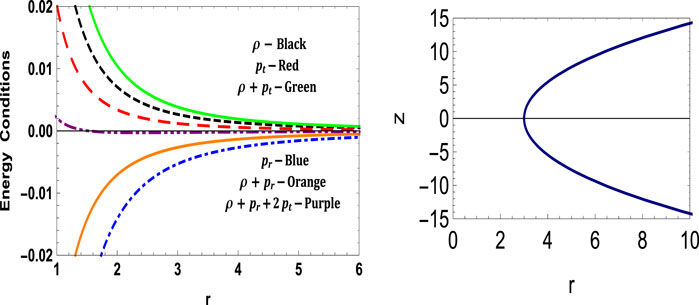
FIGURE 2. Variation of energy conditions and embedding diagram for the model I with a = 3, λ = 1.2, ω = −2 and n = 0.4.
3.2 Model II:
For this shape function in the linear EoS, the field equations lead to
which is not exactly integrable, however, one can always find the related physical quantities as they are dependent only on their derivatives. Here the physical parameters take the form
Now the energy conditions etc., can be calculated using the above expressions. Further, the variations of these physical parameters can be seen in Figures 4, 5. The throat radius is found to be 2 km and is opened by phantom energy.
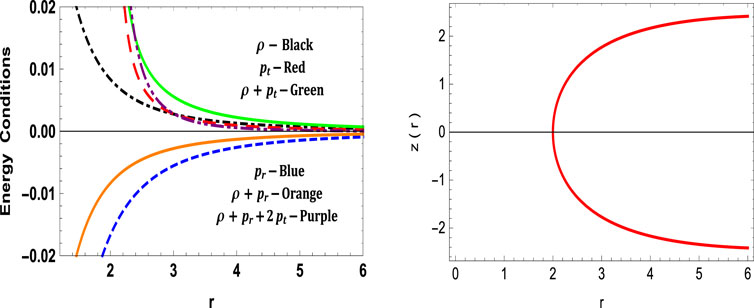
FIGURE 5. Variation of energy conditions and embedding surface for model II with a = 2, λ = 1.2, ω = −2, c = −0.16.
3.3 Model III:
The solution, in this case, is found to be
Further, the physical quantities are found to be
The variations of these physical quantities are given in Figures 6, 7. Here also, the NEC is violated, and therefore the WH throat is supported by the exotic matter which is found to be phantom energy. The revolution of the embedded surface can be seen in Figure 8.
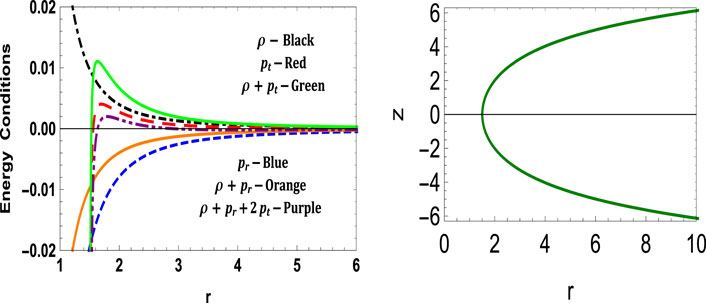
FIGURE 7. Variation of energy conditions and embedding surface for model III with a = 1.5, λ = 1.2, ω = −2, c = 0.35.
4 Finslerian wormholes with pt = npr
Unlike the first method we have adopted above, we would like to extend our investigation by assuming a linear relationship between the tangential and radial pressure as pt = npr, where n can be treated as an anisotropic parameter. To solve the field equations, further we ansatz different forms of f(r).
4.1 Model IV: f(r) = c
For the initial assumptions pt = npr and f(r) = c, the resulting solution is
with H as the constant of integration. Here one can clearly see that this solution is not asymptotically flat since
where R is the surface when the two spacetimes meet. Using (Eq. 44), we get
Which leads to a constraint on the constants H and c as
Now the density, pressures, and energy conditions are given by
The variations of b(r), b′(r) and b(r) − r is given in Figure 9. The variations of pr, pt, and energy density can be seen in Figure 10. Here we can see that the throat radii are the same for all the EoS parameters ω = −4.98, − 2.5, − 1.66, − 1.24. Again, the NEC is violated, and the corresponding EoS parameter ωr = pr/ρ is less than −1 thereby, the WH is supported by phantom energy. The surface revolution of the embedded surface is shown in Figure 11.
4.2 Model V:
For this redshift function, one can find the solution as
where M is the constant of integration. Again, this solution is not asymptotically flat due to
These above equations lead to a constraint given as
where,
Now the density and pressure take form
And the energy conditions take the very simple forms
The variations of pressure, density, energy conditions, etc. are shown in Figures 12, 13. Here one can observe that the throat radius depends on the parameter n for which the rth is smaller for n = −1 and larger for n = −0.07. Further, EoS parameter ω also increases when n increases leading to more exotic matter and thereby wider throat radius. Further, the violation of NEC and ωr = pr/ρ < − 1 shows that the matter is exotic (phantom energy).
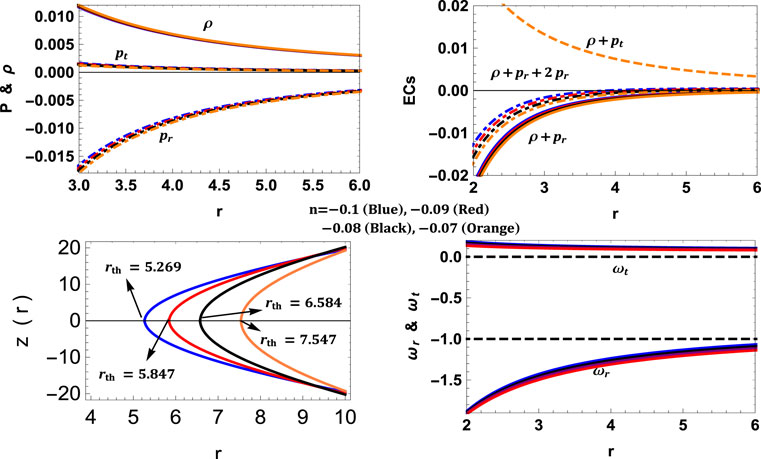
FIGURE 13. Variation of energy conditions and embedding surface for model V with λ = 3, γ = 1.5, M = 2.
5 Finslerian wormholes with specific density profile and a linear EoS (model VI)
To find the third category of solutions, we will assume a specific density profile with a linear equation of state of the form
From the first relation with the field equation, we get
where F is the constant of integration. Since the expression of the shape function doesn’t include ω, its throat will not be affected by EoS parameter. And the linear EoS with the density profile after using the field equations and the above b(r), we can find f′(r) as
Which is not exactly integrable. Although, one can find the physical parameters as
Figure 14 shows the behavior of the shape function and its related parameters. The trends of pressures, density and energy conditions are given in Figure 15, which shows that the NEC is again violated. The nature of the exotic matter can be known if we see the EoS parameter ωr = pr/ρ. Here ω = −1.5, i.e. less than −1, so again the exotic matter is phantom energy. The rth depends on the parameter α, smaller values of α yields narrower throats and vice versa.
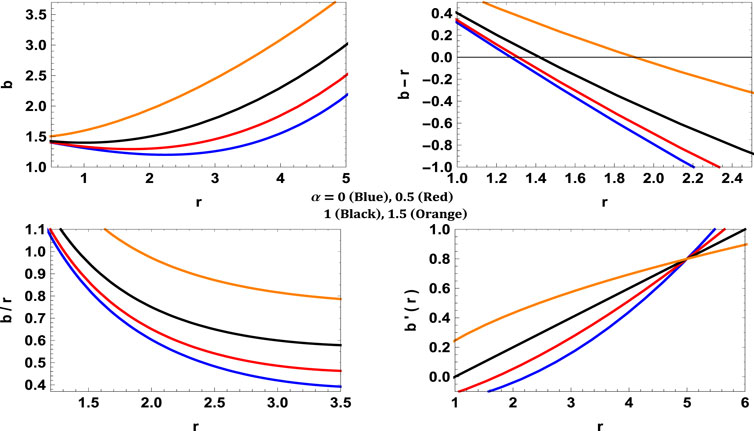
FIGURE 14. Variation of b, b−2, b/r and b′(r) for model VI with c = 0.04, λ = 1.2, F = 1.5, a = 5, ω = −1.5.
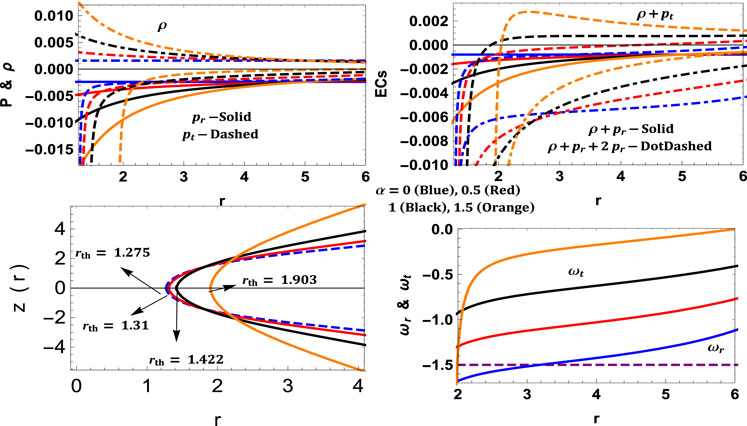
FIGURE 15. Variation of energy conditions and embedding surface for model VI with c = 0.04, λ = 1.2, F = 1.5, a = 5, ω = −1.5.
6 Construction of embedding diagrams
Considering a constant time slice i.e., yt = 0 and in the 2-dimensional Finsler space
If this Eq. 71 reduces to a 3-D cylindrical coordinate of the form
than by comparing (Eq. 71) and (Eq. 72), the form of z(r) can be found as
On simplifying (Eq. 73) we get
For model I, Eq. 74 is not integrable for the general case, however integrable for a given value of n. Further, for model II i.e.,
In a similar fashion, the embedding surface for model IV is found to be
Again, due to the non-integrability of Eq. 74 for model V and VI, we have used numerical integration to generate the 2-D embedding surface.
7 Results and discussions
In this work, we have presented six new wormhole (WH) solutions in Finslerian geometry. The first three models assumed a linear EoS along with specific forms of the shape function. The next two solutions were found by considering a linear relation between pr and pt through a constant parameter n. To close the system of equations, we have assumed two different redshift functions. Here the throat radius of WH IV depends on the redshift function only, however for the WH V, the rth depends on the anisotropic parameter n, i.e., more anisotropy makes the throat narrower and vice versa. Finally, the last solution was obtained via a linear EoS and a specific form of the density profile. In this case, the throat radius depends on density-related α parameter, more the density larger is the rth.
Next, we have determined all the embedded surfaces for each WHs in 3D Euclidean space assuming an instant of time t = constant and
Data availability statement
The original contributions presented in the study are included in the article/supplementary material, further inquiries can be directed to the corresponding author.
Author contributions
KNS conceptualized the manuscript including mathematical calculations, graph plotting, result analysis, and interpretations, FR did mathematical calculations and the resulting analysis, DD did the writing of the manuscript and interpretation of the results, SM did the editing, literature survey and the resulting analysis.
Acknowledgments
KNS and FR are thankful to the authorities of the Inter-University Centre for Astronomy and Astrophysics, Pune, India for providing the research facilities.
Conflict of interest
The authors declare that the research was conducted in the absence of any commercial or financial relationships that could be construed as a potential conflict of interest.
Publisher’s note
All claims expressed in this article are solely those of the authors and do not necessarily represent those of their affiliated organizations, or those of the publisher, the editors and the reviewers. Any product that may be evaluated in this article, or claim that may be made by its manufacturer, is not guaranteed or endorsed by the publisher.
References
1. Fuller RW, Wheeler JA. Causality and multiply connected space-time. Phys Rev (1962) 128:919–29. doi:10.1103/physrev.128.919
6. Morris MS, Thorne KS. Wormholes in spacetime and their use for interstellar travel: A tool for teaching general relativity. Am J Phys (1988) 56:395–412. doi:10.1119/1.15620
8. Morris MS, Thorne KS, Yurtsever U. Wormholes, time machines, and the weak energy condition. Phys Rev Lett (1988) 61:1446–9. doi:10.1103/physrevlett.61.1446
9. Frolov VP, Novikov ID. Physical effects in wormholes and time machines. Phys Rev D (1990) 42:1057–65. doi:10.1103/physrevd.42.1057
10. Visser M, Kar S, Dadhich N. Traversable wormholes with arbitrarily small energy condition violations. Phys Rev Lett (2003) 90:201102. doi:10.1103/physrevlett.90.201102
11. Hochberg D, Visser M. Geometric structure of the generic static traversable wormhole throat. Phys Rev D (1997) 56:4745–55. doi:10.1103/physrevd.56.4745
12. Ida D, Hayward SA. How much negative energy does a wormhole need?. Phys Lett A (1999) 260:175–81. doi:10.1016/s0375-9601(99)00518-6
13. Fewster CJ, Roman TA. On wormholes with arbitrarily small quantities of exotic matter. Phys Rev D (2005) 72:044023. doi:10.1103/physrevd.72.044023
14. Kuhfittig PKF. More on wormholes supported by small amounts of exotic matter. Phys Rev D (2006) 73:084014. doi:10.1103/physrevd.73.084014
15. Rahaman F, Kalam M, Sarker M, Gayen K. A theoretical construction of wormhole supported by phantom energy. Phys Lett B (2006) 633:161–3. doi:10.1016/j.physletb.2005.11.080
16. Jamil M, Kuhfittig PKF, Rahaman F, Rakib SA. Wormholes supported by polytropic phantom energy. Eur Phys J C (2010) 67:513–20. doi:10.1140/epjc/s10052-010-1325-3
17. Teo E. Rotating traversable wormholes. Phys Rev D (1998) 58:024014. doi:10.1103/physrevd.58.024014
18. Kuhfittig PKF. Axially symmetric rotating traversable wormholes. Phys Rev D (2003) 67:064015. doi:10.1103/physrevd.67.064015
19. Hochberg D, Visser M. Dynamic wormholes, antitrapped surfaces, and energy conditions. Phys Rev D (1998) 58:044021. doi:10.1103/physrevd.58.044021
21. Lemos JPS, Lobo FSN, de Oliveira SQ. Morris-Thorne wormholes with a cosmological constant. Phys Rev D (2003) 68:064004. doi:10.1103/physrevd.68.064004
22. Rahaman F, Kalam M, Sarker M, Ghosh A, Raychaudhuri B. Wormhole with varying cosmological constant. Gen Relativ Gravit (2007) 39:145–51. doi:10.1007/s10714-006-0380-4
23. Wang D, Meng X-H. Traversable geometric dark energy wormholes constrained by astrophysical observations. Eur Phys J C (2016) 76:484. doi:10.1140/epjc/s10052-016-4321-4
24. Lobo FSN. Stability of phantom wormholes. Phys Rev D (2005) 71:124022. doi:10.1103/physrevd.71.124022
25. Banerjee A, Singh KN, Jasim M, Rahaman F. Conformally symmetric traversable wormholes in f(R, T) gravity. Ann Phys (2020) 422:168295. doi:10.1016/j.aop.2020.168295
26. Singh KN, Banerjee A, Rahaman F, Jasim MK. Conformally symmetric traversable wormholes in modified teleparallel gravity Phys Rev D (2020) 101:084012. doi:10.1103/PhysRevD.101.084012
27. Rahaman F, Sarkar S, Singh KN, Pant N. Generating functions of wormholes. Mod Phys Lett A (2019) 34:1950010. doi:10.1142/s021773231950010x
28. Banados M, Bautier K, Coussaert O, Henneaux M, Ortiz M. Anti–de Sitter–CFT correspondence in three-dimensional supergravity. Phys Rev D (1998) 58:085020. doi:10.1103/physrevd.58.085020
29. Cvetič M, Nojiri S, Odintsov SD. Cosmological anti–de Sitter space-times and time-dependent AdS/CFT correspondence. Phys Rev D (2004) 69:023513. doi:10.1103/physrevd.69.023513
30. Bao D, Chern SS, Shen Z. An introduction to riemann-finsler geometry, graduate texts in mathematics. New York: Springer (2000).
31. Rutz SF. A Finsler generalisation of Einstein's vacuum field equations. Gen Relat Gravit (1993) 25:1139–58. doi:10.1007/bf00763757
32. Vacaru S, Stavrinos P, Gaburov E, Gonta D. Clifford and Riemann–Finsler structures in geometric mechanics and gravity. Buchares: Geometry Balkan Press (2005).
33. Pfeifer C, Wohlfarth MNR. Finsler geometric extension of Einstein gravity. Phys Rev D (2012) 85:064009. doi:10.1103/physrevd.85.064009
34. Rahaman F, Paul N, Banerjee A, De SS, Ray S, Usmani AA. The Finslerian wormhole models. Eur Phys J C (2016) 76:246. doi:10.1140/epjc/s10052-016-4066-0
35. Girelli F, Liberati S, Sindoni L. Planck-scale modified dispersion relations and Finsler geometry. Phys Rev D (2007) 75:064015. doi:10.1103/physrevd.75.064015
36. Gibbons GW, Gomis J, Pope CN. General very special relativity is Finsler geometry. Phys Rev D (2007) 76:081701. doi:10.1103/physrevd.76.081701
37. Chang Z, Li X. Lorentz invariance violation and symmetry in Randers–Finsler spaces. Phys Lett B (2008) 663:103–6. doi:10.1016/j.physletb.2008.03.045
38. Kostelecky VA. Riemann–Finsler geometry and Lorentz-violating kinematics. Phys Lett B (2011) 701:137. doi:10.1016/j.physletb.2011.05.041
39. Kostelecky VA, Russell N, Tsoc R. Bipartite Riemann–Finsler geometry and Lorentz violation. Phys Lett B (2012) 716:470. doi:10.1016/j.physletb.2012.09.002
40. Kouretsis AP, Stathakopoulos M, Stavrinos PC. General very special relativity in Finsler cosmology. Phys Rev D (2009) 79:104011. doi:10.1103/physrevd.79.104011
41. Kouretsis AP, Stathakopoulos M, Stavrinos PC. Imperfect fluids, Lorentz violations, and Finsler cosmology. Phys Rev D (2010) 82:064035. doi:10.1103/physrevd.82.064035
42. Li X, Lin HN, Wang S, Chang Z. Anisotropic inflation in the Finsler spacetime. Eur Phys J C (2015) 75:260. doi:10.1140/epjc/s10052-015-3468-8
43. Minguzzi E. Raychaudhuri equation and singularity theorems in Finsler spacetimes. Class Quan Grav (2015) 32:185008. doi:10.1088/0264-9381/32/18/185008
44. Stavrinos PC, Alexiou M. Raychaudhuri equation in the Finsler–Randers space-time and generalized scalar-tensor theories. Int J Geom Methods Mod Phys (2018) 15:1850039. doi:10.1142/s0219887818500391
45. Aazami AB, Javaloyes MA. Penrose’s singularity theorem in a Finsler spacetime. Class Quan Grav (2016) 33:025003. doi:10.1088/0264-9381/33/2/025003
46. Rahaman F, Paul N, De SS, Ray S, Jafry MAK. The Finslerian compact star model. Eur Phys J C (2015) 75:564. doi:10.1140/epjc/s10052-015-3797-7
47. Chowdhury SR. Hawking emission of charged particles from an electrically charged spherical black hole with scalar hair. Eur Phys J C (2019) 79:928. doi:10.1140/epjc/s10052-019-7452-6
48. Li X. Special finslerian generalization of the reissner-nordström spacetime. Phys Rev D (2018) 98:084030. doi:10.1103/physrevd.98.084030
49. Li X, Chang Z. Exact solution of vacuum field equation in Finsler spacetime. Phys Rev D (2014) 90:064049. doi:10.1103/physrevd.90.064049
50. Övgün A, Jusufi K, Sakallı İ. Exact traversable wormhole solution in bumblebee gravity. Phys Rev D (2019) 99:024042. doi:10.1103/physrevd.99.024042
52. Övgün A, Sakalli I. A particular thin-shell wormhole. Theor Math Phys (2017) 190:120–9. doi:10.1134/s004057791701010x
53. Sakalli I, Ovgun A. Gravitinos tunneling from traversable Lorentzian wormholes. Astrophys Space Sci (2015) 359:32. doi:10.1007/s10509-015-2482-5
54. Sakalli I, Övgün A. Tunnelling of vector particles from Lorentzian wormholes in 3+1 dimensions. Eur Phys J Plus (2015) 130:110. doi:10.1140/epjp/i2015-15110-9
55. Jusufi K, Övgün A, Banerjee A, Sakallı İ. Gravitational lensing by wormholes supported by electromagnetic, scalar, and quantum effects. Eur Phys J Plus (2019) 134:428. doi:10.1140/epjp/i2019-12792-9
56. Lake MJ. Modelling cosmic springs with finsler and generalised finsler geometries. Symmetry (2022) 14:2166. doi:10.3390/sym14102166
57. Caxathodory C. Variationsrechnung und partielle Differenialgleiehungenerster Ordnung. Leipzig: Teubner Press (1935).
58. Bao D, Chern SS, Shen Z. An introduction to riemann–finsler geometry. New York: Springer (2000).
Appendix A: Derivation of Einstein-Finsler field equation
Usually, the expression of the length for a curve in a Finslerian metric geometry is
Lorentzian metric gab defines the function
The Einstein-Finsler gravitational field equations are derived by the calculus of variations and in the framework of the tangent bundle of spacetime, i.e. can be derived from the action principle. Here the action (integral of Lagrangian density over spacetime) is defined as a union of the matter (SM) and the Einstein-Hilbert (SEH) action that couples gravity to matter and is given by
In the Finsler space
The action, i.e. the integral of Lagrangian density is varied with respect to
Now,
where fR = ∂f/∂R and over the sphere bundle the function f = fabyayb [30]. Here,
The relation between δgab and
Using the above two equations, one can obtain finally
In the Finslerian background the matter action for matter fields ψi looks like (L is the Lagrangian density of the matter fields)
Since L and g are independent on θ over the fiber coordinates on the manifold
According to Pfeifer and Wohlfarth [33], in the Finsler background, the variation with respect to the Finsler function yields the Energy-Momentum tensor of p-form fields on Lorentzian metric spacetime as Tab as well as its trace
Next taking the variation with respect to
The structure of spacetime can be determined from the following equation,
Here we have considered the vanishing Cartan tensor and for that, the tensors in the bracket are y independent.
The second derivative of the above with respect to fiber coordinates yields the Einstein-Finsler gravitational field equations as
Here we set the coupling constant
To define the wormhole structure, we assume the Finsler structure is of the form
One can write the metric structure coefficient as
where (gμν) =
For a non-vanishing vector
where
The Finsler metric are given below
where
Keywords: Finsler geometry, wormholes, energy conditions, phantom energy, embedding diagram
Citation: Singh KN, Rahaman F, Deb D and Maurya SK (2023) Traversable Finslerian wormholes supported by phantom energy. Front. Phys. 10:1038905. doi: 10.3389/fphy.2022.1038905
Received: 07 September 2022; Accepted: 07 December 2022;
Published: 04 January 2023.
Edited by:
Farruh Atamurotov, Inha University in Tashkent, UzbekistanReviewed by:
Abdul Jawad, COMSATS University Islamabad, PakistanIzzet Sakalli, Eastern Mediterranean University, Turkey
Ali Övgün, Eastern Mediterranean University, Turkey
Copyright © 2023 Singh, Rahaman, Deb and Maurya. This is an open-access article distributed under the terms of the Creative Commons Attribution License (CC BY). The use, distribution or reproduction in other forums is permitted, provided the original author(s) and the copyright owner(s) are credited and that the original publication in this journal is cited, in accordance with accepted academic practice. No use, distribution or reproduction is permitted which does not comply with these terms.
*Correspondence: Ksh. Newton Singh, bmV3dG9uLmtzaGV0cmltYXl1bUBhc3NvY2lhdGVzLml1Y2FhLmlu
 Ksh. Newton Singh
Ksh. Newton Singh Farook Rahaman2
Farook Rahaman2 Debabrata Deb
Debabrata Deb S. K. Maurya
S. K. Maurya

